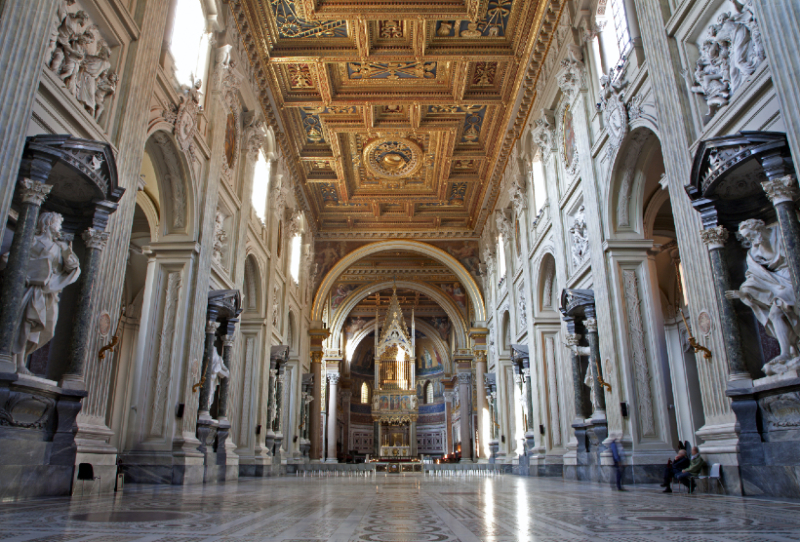
Rome – basilica of Lateran basilica of St. John By Renáta Sedmáková
HISTORICAL ITINERARY
It was to Pope Melchiades (311-14) that Constantine gave his Lateran Palace, so-called because it had earlier been the property of the patrician Laterani family, which his second wife Fausta (Maxentius’ sister) had brought to the marriage. Soon after, the Emperor razed the adjoining imperial horseguards’ barracks (allegedly the equites singulares had supported Maxentius against Constantine) and commissioned the construction of the world’s first major Christian basilica on that site.
The Lateran Palace, known as the Patriarchate, was the Popes’ official residence until the late fourteenth century. The basilica, consecrated in 324 by Melchiades’ successor, Pope Sylvester I (314-35), was dedicated, by will of the Emperor, to Christ the Saviour. In the tenth century Pope Sergius III (904-11) added St. John the Baptist, and in the twelfth century Pope Lucius (1144-5) added St. John the Evangelist to the basilica’s dedication.
In the course of its history, St. John Lateran suffered just about as many disasters and revivals as the Papacy it hosted. Sacked by Alaric in 410 and Genseric in 455, it was rebuilt by Pope St. Leo the Great (440-61) and centuries later by Pope Hadrian I (772-95). Almost entirely destroyed by an earthquake in 896, the basilica was again restored by Pope Sergius III (904-11). Later the church was heavily damaged by fires in 1308 and 1360.
When the Popes returned from their sojourn in Avignon (1305-1378), they found their basilica and palace in such disrepair that they decided to transfer to the Vatican, near St. Peter’s. (That basilica, also built by Constantine, had until then served primarily as a pilgrimage church.)
Pope Sixtus V (1585-90), in one of his frenzied urban renewal projects, tore down St. John Lateran’s original buildings, replacing them with late Renaissance structures by his favourite architect, Domenico Fontana (1543-1607). Later, Pope Innocent X (1644-55) engaged one of the Baroque’s most brilliant architects, Francesco Borromini (1599-1667), to transform St. John Lateran’s interior in time for the Jubilee of 1650. Finally, Pope Clement XII (1730-40) launched a competition for the design of a new facade, which was completed by Alessandro Galilei in 1735.
Of the original Lateran basilica and palace, only the Popes’ private chapel, the Sancta Sanctorum, remains. Sixtus V removed this magnificently frescoed shrine to what has become a grimy traffic island. As an approach to the chapel, Sixtus moved from the Lateran Palace the Scala Sancta, the staircase which Jesus supposedly ascended to Pontius Pilate’s palace in Jerusalem, and which, according to tradition, was brought to Rome by St. Helena herself.
Many important historic events have taken place in St. John Lateran, including five Ecumenical Councils and many diocesan synods. In 1929 the Lateran Pacts, which established the territory and status of the State of Vatican City, were signed here between the Holy See and the Government of Italy.
Since the late fourteenth century the Popes have resided in the Vatican, and St. Peter’s Basilica now hosts the most important Papal ceremonies. St. John Lateran is still, however, Rome’s only cathedral, the original and continuing church for the Pope as the Bishop of Rome. In fact, the term cathedral actually refers to a bishop’s church, more precisely a church with a bishop’s throne (cathedra). Every year the Holy Thursday liturgy, when the Holy Father symbolically washes the feet of priests chosen from various parts of the world, is celebrated in St. John Lateran.
The offices of the Cardinal Vicar of Rome now occupy the Lateran Palace. On the night of 27 July 1993, a bomb explosion (simultaneous with that in San Giorgio in Velabro across the city, and likewise an act of Mafia terrorism) devastated the facade of the Rome Vicariate of San Giovanni in Laterano. Repairs were completed in 1996.
Excerpt from Hager, June. Pilgrimage: A Chronicle of Christianity Through the Churches of Rome. (Weidenfeld & Nicolson: London), 1999.
We will be going to visit the Basilica of St. John Lateran in our upcoming Journey Toward the Face of Christ pilgrimage this coming May/June 2022.








Leave A Comment
You must be logged in to post a comment.